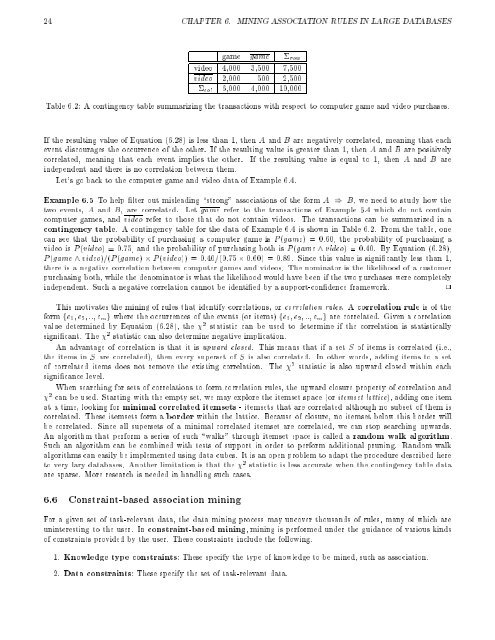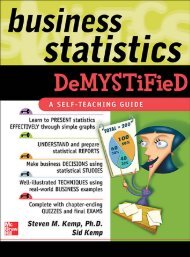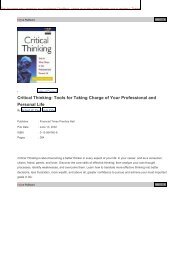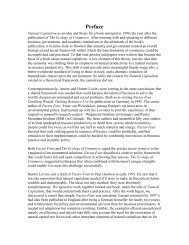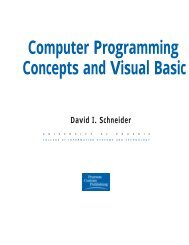Chapter 06 - Changing Education Paradigm
Chapter 06 - Changing Education Paradigm
Chapter 06 - Changing Education Paradigm
Create successful ePaper yourself
Turn your PDF publications into a flip-book with our unique Google optimized e-Paper software.
24 CHAPTER 6. MINING ASSOCIATION RULES IN LARGE DATABASES<br />
game game row<br />
video 4,000 3,500 7,500<br />
video 2,000 500 2,500<br />
col 6,000 4,000 10,000<br />
Table 6.2: A contingency table summarizing the transactions with respect to computer game and video purchases.<br />
If the resulting value of Equation (6.28) is less than 1, then A and B are negatively correlated, meaning that each<br />
event discourages the occurrence of the other. If the resulting value is greater than 1, then A and B are positively<br />
correlated, meaning that each event implies the other. If the resulting value is equal to 1, then A and B are<br />
independent and there is no correlation between them.<br />
Let's go back to the computer game and video data of Example 6.4.<br />
Example 6.5 To help lter out misleading \strong" associations of the form A ) B, we need to study how the<br />
two events, A and B, are correlated. Let game refer to the transactions of Example 6.4 which do not contain<br />
computer games, and video refer to those that do not contain videos. The transactions can be summarized in a<br />
contingency table. A contingency table for the data of Example 6.4 is shown in Table 6.2. From the table, one<br />
can see that the probability of purchasing a computer game is P (game) =0:60, the probability of purchasing a<br />
video is P (video) =0:75, and the probability of purchasing both is P (game ^ video) =0:40. By Equation (6.28),<br />
P (game ^ video)=(P (game) P (video))=0:40=(0:75 0:60) = 0.89. Since this value is signi cantly less than 1,<br />
there is a negative correlation between computer games and videos. The nominator is the likelihood of a customer<br />
purchasing both, while the denominator is what the likelihood would have been if the two purchases were completely<br />
independent. Such a negative correlation cannot be identi ed by a support-con dence framework. 2<br />
This motivates the mining of rules that identify correlations, or correlation rules. A correlation rule is of the<br />
form fe1;e2; ::; emg where the occurrences of the events (or items) fe1;e2; ::; emg are correlated. Given a correlation<br />
value determined by Equation (6.28), the 2 statistic can be used to determine if the correlation is statistically<br />
signi cant. The<br />
2 statistic can also determine negative implication.<br />
An advantage of correlation is that it is upward closed. This means that if a set S of items is correlated (i.e.,<br />
the items in S are correlated), then every superset of S is also correlated. In other words, adding items to a set<br />
of correlated items does not remove the existing correlation. The 2 statistic is also upward closed within each<br />
signi cance level.<br />
When searching for sets of correlations to form correlation rules, the upward closure property of correlation and<br />
2 can be used. Starting with the empty set, we may explore the itemset space (or itemset lattice), adding one item<br />
at a time, looking for minimal correlated itemsets - itemsets that are correlated although no subset of them is<br />
correlated. These itemsets form a border within the lattice. Because of closure, no itemset below this border will<br />
be correlated. Since all supersets of a minimal correlated itemset are correlated, we can stop searching upwards.<br />
An algorithm that perform a series of such \walks" through itemset space is called a random walk algorithm.<br />
Such an algorithm can be combined with tests of support in order to perform additional pruning. Random walk<br />
algorithms can easily be implemented using data cubes. It is an open problem to adapt the procedure described here<br />
to very lary databases. Another limitation is that the 2 statistic is less accurate when the contingency table data<br />
are sparse. More research is needed in handling such cases.<br />
6.6 Constraint-based association mining<br />
For a given set of task-relevant data, the data mining process may uncover thousands of rules, many of which are<br />
uninteresting to the user. In constraint-based mining, mining is performed under the guidance of various kinds<br />
of constraints provided by the user. These constraints include the following.<br />
1. Knowledge type constraints: These specify the type of knowledge to be mined, such as association.<br />
2. Data constraints: These specify the set of task-relevant data.


